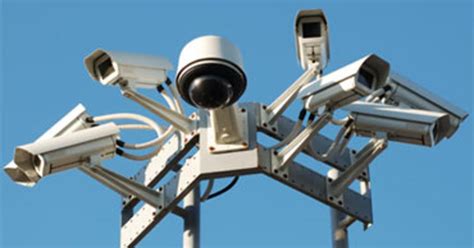
Saturday, June 20
There are more news reports regarding the use of aircraft to monitor demonstrations. The Times now says that the Department of Homeland Security employed drones, helicopters, and airplanes to spy on Black Lives Matter protests in 15 cities from Minneapolis to Buffalo.
It’s all part of a Homeland Security digital network called “Big Pipe” that can be accessed by a range of federal and local authorities. Collectively, the aircraft logged at least 270 hours of surveillance.
But what about old-fashioned CCTV? Have we come to accept that as a given—a loss of privacy we have to live with?
In Britain, The Guardian reported back in 2011 that there was one CCTV camera for every 32 citizens. So there must be many more cameras now.
Many of these U.K. cameras were inside private premises, including malls and stores, although police have easy access to such video. But American cities put a lot of cameras right out in the open.
New York City’s “domain awareness system”—a partnership between the police and Microsoft Corp.—utilizes 18,000 video surveillance cameras. The city’s subway system has over 4,000 cameras (although nearly half of them do not work), and two-thirds of large apartment and commercial buildings have video surveillance.
The city’s system links up license-plate readings, court summonses, 911 calls, and police reports. Some $350 million in Homeland Security money got New York’s network started, but today the system is a money-maker for the city. Its approach and software are licensed out everywhere from Washington, D.C. to Brazil and Singapore.
In the Washington D.C.-area, there are more than 30,000 surveillance cameras in schools, and that city’s subway employs nearly 6,000 cameras.
Much has been made of the U.S. Constitution’s “right to privacy,” especially with regard to Supreme Court abortion-rights rulings. But courts have facilitated access to CCTV footage, and the American Civil Liberties Union says there has been very little explicit regulation of video. “There are currently no general, legally enforceable rules to limit privacy invasions and protect against abuse of CCTV systems,” says the ACLU.
I myself have been victimized in a very small way by these cameras. A while back, I received two notices via e-mail and snail-mail of “red light violations.” One of these included a photo of my car (presumably, I was at the wheel) running a Manhattan red light at the corner of 26th St. and Second Avenue. The light did indeed look red in the printed-out version, but it was clearly only yellow in the e-mailed version. In any case, the notice said, the summons was not appealable—pay or die.
My online research revealed that the camera was put there by the city and its partner Xerox Corp. (When was the last time you heard of them?) Both make good moola off this labor-free gotcha gimmick.
The red-light-camera gambit has drawn plenty of public complaints. Apparently, the system has a hair trigger that’s prone to entrapping drivers who are mid-intersection when the light changes. On Long Island, the red-light traps have resulted in lots of rear-end collisions, as wary drivers slam on the brakes when they see a light turn yellow, only to be rear-ended by the driver behind them.
But the issue of the moment is much larger than red-light entrapment. It concerns surveillance of demonstrators exercising their constitutional rights of freedom of expression and assembly. And as can be easily seen, the “authorities” are openly hostile to such demonstrations.
Dinner: homemade pizza and a lettuce, cucumber, and radish salad.
Entertainment: More episodes of Marcella, from season two, and one episode of the David Attenborough nature documentary Our Planet.
